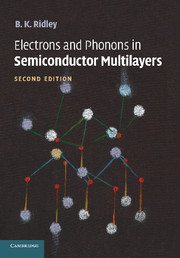Book contents
- Frontmatter
- Contents
- Preface
- Introduction
- 1 Simple Models of the Electron–Phonon Interaction
- 2 Quantum Confinement of Carriers
- 3 Quasi-Continuum Theory of Lattice Vibrations
- 4 Bulk Vibrational Modes in an Isotropic Continuum
- 5 Optical Modes in a Quantum Well
- 6 Superlattice Modes
- 7 Optical Modes in Various Structures
- 8 Electron–Optical Phonon Interaction in a Quantum Well
- 9 Other Scattering Mechanisms
- 10 Quantum Screening
- 11 The Electron Distribution Function
- 12 Spin Relaxation
- 13 Electrons and Phonons in the Wurtzite Lattice
- 14 Nitride Heterostructures
- 15 Terahertz Sources
- Appendix 1 The Polar-Optical Momentum-Relaxation Time in a 2D Degenerate Gas
- Appendix 2 Electron/Polar Optical Phonon Scattering Rates in a Spherical Cosine Band
- References
- Index
13 - Electrons and Phonons in the Wurtzite Lattice
Published online by Cambridge University Press: 05 September 2009
- Frontmatter
- Contents
- Preface
- Introduction
- 1 Simple Models of the Electron–Phonon Interaction
- 2 Quantum Confinement of Carriers
- 3 Quasi-Continuum Theory of Lattice Vibrations
- 4 Bulk Vibrational Modes in an Isotropic Continuum
- 5 Optical Modes in a Quantum Well
- 6 Superlattice Modes
- 7 Optical Modes in Various Structures
- 8 Electron–Optical Phonon Interaction in a Quantum Well
- 9 Other Scattering Mechanisms
- 10 Quantum Screening
- 11 The Electron Distribution Function
- 12 Spin Relaxation
- 13 Electrons and Phonons in the Wurtzite Lattice
- 14 Nitride Heterostructures
- 15 Terahertz Sources
- Appendix 1 The Polar-Optical Momentum-Relaxation Time in a 2D Degenerate Gas
- Appendix 2 Electron/Polar Optical Phonon Scattering Rates in a Spherical Cosine Band
- References
- Index
Summary
What immortal hand or eye Could frame thy fearful symmetry?
Songs of Experience, William BlakeThe Wurtzite Lattice
Wurtzite is zinc oxide. Its lattice is made up of tetrahedrally bonded atoms, as it is in zinc blende, but it differs in the stacking sequence: in zinc blende the structure has face-centred cubic symmetry, in wurtzite the structure has hexagonal symmetry. The wurtzite lattice is the preferred thermodynamically stable phase of a number of binary semiconductors, among them the nitrides, AlN, GaN, and InN, which have become of considerable technical importance in recent years. Among the applications are high-power microwave transistors, light-emitting diodes, and highly efficient solar cells. If the paradigm of the cubic III-V semiconductors is GaAs, the paradigm of the hexagonal nitrides is GaN. Being familiar with the properties of GaAs, we need to know how the lower symmetry of GaN affects the band structure of electrons and holes, the phonon spectrum and the electron–phonon interaction. We focus on these topics in this chapter. Fuller accounts of the properties of the nitrides can be found in a number of excellent reviews (e.g. Ambacher, 1998; Ambacher et al., 2002; Piprek (ed.) Nitride Semiconductor Devices, 2007).
The unit cell of the wurtzite lattice is depicted in Fig. 13.1. It consists of stacked hexagonal planes so that were the atoms to be spherical with the same radius, the lattice would be a close-packed hexagonal structure.
- Type
- Chapter
- Information
- Electrons and Phonons in Semiconductor Multilayers , pp. 336 - 348Publisher: Cambridge University PressPrint publication year: 2009



